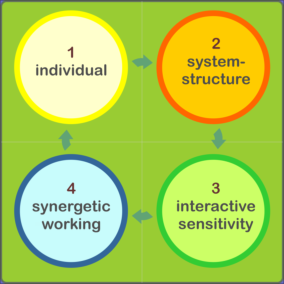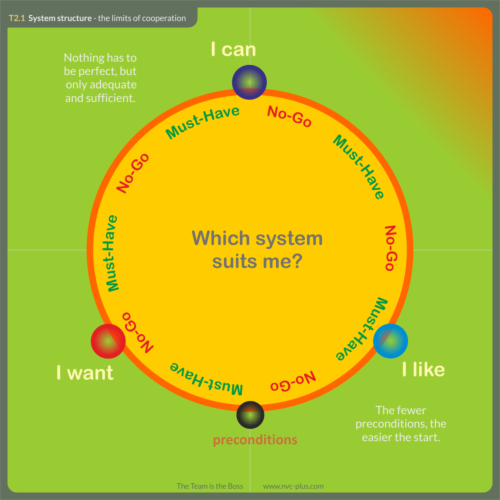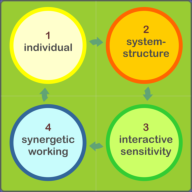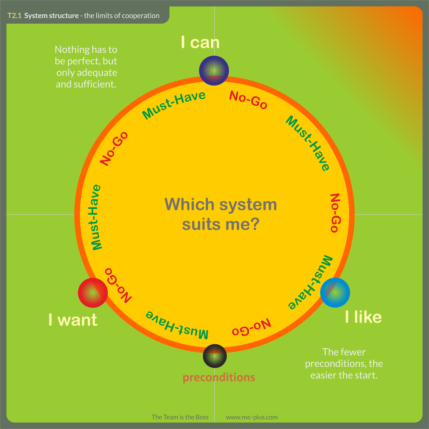
How to turn your team
into the boss


- The 6 Hurdles
- The Elements
- What are the Elements
- Culture Stage Model
- Gut, Head or Herart Process
- Culture Change
- List of Feelings and Needs
- Emergency Emo-Step
- Four Step Circle
- NVC Magic Circle
- Utopia Magic Circle
- Utopia and Vision
- No-Goes and Must-Haves
- Pain Points
- Consensus
- Requirement Lists
- NVC-plus Strategy
- NVC-plus Matrix
- Discourse
- Card Set
- Download-Tool-Depot
- FAQs
- Events
- Media

6 Hurdles to Self-Organization
Chapter 17 – No-Gos and Must-Haves




Successful
cooperation
is
both
a
path
and
a
goal.
Good
methods
and
tools
make
it
much
easier
for
a
team
to
organize
itself.
Encourage
your
team
to
take
the
first
steps
in
this
direction
and
experience the difference.
No-Gos und Must-Haves
Everyone
has
boundaries
that
are
difficult
to
overcome.
These
boundaries
limit
our
ability
to
work
together.
We
should
therefore
be
aware
of
them
as
early
as
possible
so
that
we
know
whether
we
even
have
enough
room
for
our
project
within
our
common
boundaries.
If
not,
we
have
already
failed
before
we
have
even started and that is the best time to do so.
At
NVC-plus,
we
don't
discuss
people's
boundaries
or
try
to
minimize
them
and
declare
them
unimportant.
The
only
thing
we
can
try
to
do
is
to
specify
them
more
precisely
so
that
a
no-go
does
not
include
larger
areas
that
do
not
belong.
For
example,
if
someone
has
identified
fruit
salad
as
a
no-go,
then
we
can
ask
whether
avocados
are
also
included
and
what
about
cucumbers
and
tomatoes.
Maybe
we
can
whip
up
something
tasty
after
all.
So
it's
about
communicating
and
accepting
boundaries.
But
these
are
always
personal
boundaries.
It's
not
about
what
'you'
don't
do,
shouldn't
do
or
must
do.
It's
about
what
is
too
much
for
me
or
you
and
what
I
need
and
you
need
in
order
to
be
there.
The
reasons
why
this
is
the
case
are
usually not important and you can almost always leave them out if you want.
The tool card T2.1
NVC-plus
has
several
tool
cards
that
are
numbered
consecutively.
Tool
card
2.1
is
the
first
tool
card
for
the
second
field
of
the
Four-Step-Circle
(small
card
on
the
right).
This
tool
card
is
about
clarifying
whether
you
and
your
people
can
form
a
team
for
your
project
that
makes
sense.
You
collect
the
No-Gos
and
Must-Haves
of
everyone
involved.
It
is
important
to
distinguish
the
"pain
points"
(card
Z1)
from
the
No-Gos
and
Must-
Haves.
Pain
points
are
unpleasant,
but
bearable.
You
can
still
work
together
even
though
you
don't
like
something
or
something
goes
against
the
grain.
However,
everyone
has
a
few
real
boundaries
and
if
these
are
affected
by
the
joint
project,
it
is
important
to
communicate
them
so
that
everyone
knows
whether
they
can
accept
the
boundaries
of
others
and
whether,
if
everyone
accepts
them,
there
are
still
opportunities
to
realize
the
desired
project.
This
should
be
done
at
the
very
beginning
of
the
project,
as
this
is
the
easiest
time
to
change
things
or
withdraw
from
the
project.
But
you
can
also
submit
No-Gos
and
Must-Haves
later
on.
At
the
beginning,
you
don't
know
how
everything
will
develop
and
you
get
wiser
over
time.
The
good
thing
is
that
solutions
for
many
No-Gos
and
Must-Haves
can
be
found
within
the
team
if
the
forces
of
the
heart
are
strong
enough,
or
come
into
play
strongly
enough
through
NVC
and
NVC-plus.
We
talk
about
"taking
heart".
If
people
don't
really
care
about
each
other,
clarifying
the
No-Gos
and
Must-
Haves
and
No-Gos
may
not
achieve
much.
And
if
they
don't
have
enough
peace
with
each
other,
they
should
first
resolve
the
conflicts
that
stand
in
the
way
of
peace
-
perhaps
with
classic
NVC
(non-violent
communication).



The cards are described in more detail in the book,
as well as in the Power Point presentation available in
the download tool depot.

Every team, start-up, or company must overcome these six hurdles if it wants to organize itself
collegially in order to successfully manage projects from within the community.

No-Goes and Must-Haves


d) No-Goes und Must-Haves




The cards are described in more detail in the
book, as well as in the Power Point
presentation available in the download tool
depot.
Chapter 17 – No-Gos and Must-Haves


- The 6 Hurdles
- The Elements
- What are the Elements
- Culture Stage Model
- Gut, Head or Herart Process
- Culture Change
- List of Feelings and Needs
- Requirement Lists
- NVC Magic Circle
- Utopia Magic Circle
- Emergency Emo-Step
- Four Step Circle
- Utopia and Vision
- No-Goes and Must-Haves
- Pain Points
- Consensus
- NVC-plus Strategy
- NVC-plus Matrix
- Discourse
- Card Set
- Download-Tool-Depot
- FAQs
- Events
- Media
Successful
cooperation
is
both
a
path
and
a
goal.
Good
methods
and
tools
make
it
much
easier
for
a
team
to
organize
itself.
Encourage
your
team
to
take
the
first
steps
in
this
direction
and
experience
the
difference.
Everyone
has
boundaries
that
are
difficult
to
overcome.
These
boundaries
limit
our
ability
to
work
together.
We
should
therefore
be
aware
of
them
as
early
as
possible
so
that
we
know
whether
we
even
have
enough
room
for
our
project
within
our
common
boundaries.
If
not,
we
have
already
failed
before
we
have
even
started
and that is the best time to do so.
At
NVC-plus,
we
don't
discuss
people's
boundaries
or
try
to
minimize
them
and
declare
them
unimportant.
The
only
thing
we
can
try
to
do
is
to
specify
them
more
precisely
so
that
a
no-
go
does
not
include
larger
areas
that
do
not
belong.
For
example,
if
someone
has
identified
fruit
salad
as
a
no-go,
then
we
can
ask
whether
avocados
are
also
included
and
what
about
cucumbers
and
tomatoes.
Maybe
we
can
whip
up
something
tasty
after
all.
So
it's
about
communicating
and
accepting
boundaries.
But
these
are
always
personal
boundaries.
It's
not
about
what
'you'
don't
do,
shouldn't
do
or
must
do.
It's
about
what
is
too
much
for
me
or
you
and
what
I
need
and
you
need
in
order
to
be
there.
The
reasons
why
this
is
the
case
are
usually
not
important
and
you
can
almost
always
leave
them
out if you want.
NVC-plus
has
several
tool
cards
that
are
numbered
consecutively.
Tool
card
2.1
is
the
first
tool
card
for
the
second
field
of
the
Four-Step-
Circle
(small
card
on
the
right).
This
tool
card
is
about
clarifying
whether
you
and
your
people
can
form
a
team
for
your
project
that
makes
sense.
You
collect
the
No-Gos
and
Must-Haves
of
everyone
involved.
It
is
important
to
distinguish
the
"pain
points"
(card
Z1)
from
the
No-Gos
and
Must-Haves.
Pain
points
are
unpleasant,
but
bearable.
You
can
still
work
together
even
though
you
don't
like
something
or
something
goes
against
the
grain.
However,
everyone
has
a
few
real
boundaries
and
if
these
are
affected
by
the
joint
project,
it
is
important
to
communicate
them
so
that
everyone
knows
whether
they
can
accept
the
boundaries
of
others
and
whether,
if
everyone
accepts
them,
there
are
still
opportunities
to
realize
the
desired
project.
This
should
be
done
at
the
very
beginning
of
the
project,
as
this
is
the
easiest
time
to
change
things
or
withdraw
from
the
project.
But
you
can
also
submit
No-Gos
and
Must-Haves
later
on.
At
the
beginning,
you
don't
know
how
everything
will
develop
and
you
get
wiser
over
time.
The
good
thing
is
that
solutions
for
many
No-Gos
and
Must-
Haves
can
be
found
within
the
team
if
the
forces
of
the
heart
are
strong
enough,
or
come
into
play
strongly
enough
through
NVC
and
NVC-plus.
We
talk
about
"taking
heart".
If
people
don't
really
care
about
each
other,
clarifying
the
No-Gos
and
Must-
Haves
and
No-Gos
may
not
achieve
much.
And
if
they
don't
have
enough
peace
with
each
other,
they
should
first
resolve
the
conflicts
that
stand
in
the
way
of
peace
-
perhaps
with
classic
NVC
(non-
violent communication).



The tool card T2.1
No-Gos und Must-Haves







































